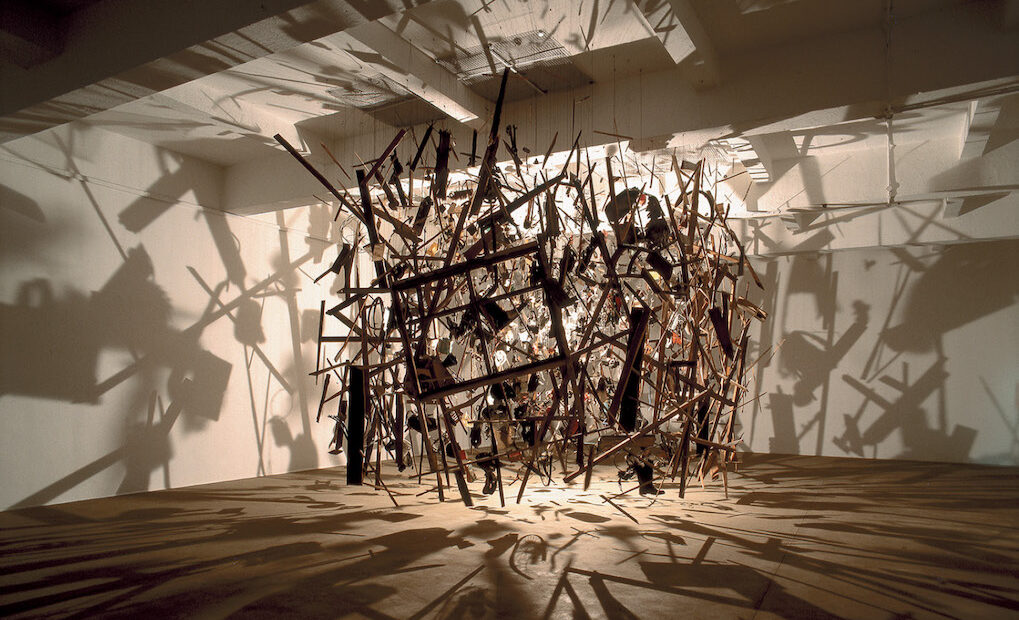Cornelia Parker at Tate Britain

Over the last four decades, 65-year-old British artist Cornelia Parker has produced some of the most thoughtful and original work in the country’s cultural landscape. Her most recognisable pieces, such as Cold Dark Matter, have often pushed the boundaries of sculpture. Now the Tate Britain is presenting a major survey of her wide-ranging career to date. Featuring close to 100 works, including installations, sculptures, photography, film and drawings, the exhibition extends its reach back to the 1980s, when Parker first rose to prominence.
Throughout, the artist’s curiosity and playful transformation of seemingly everyday objects come to the fore. A case in point can be seen in the opening room, where one finds Thirty Pieces of Silver (1988-89) – referencing the price for which Judas Iscariot betrayed Jesus – an installation of silver-plate objects gathered from charity shops and car boot sales and flattened by a steamroller. Suspended just off the floor, they resemble a shimmering lily pond.
Undercurrents of violence often seem to pervade her practice. At one stage, we encounter the artist using lead wire, created by melting down bullets, to make drawings. Elsewhere, one finds an Oliver Twist doll cut in half by the very guillotine that beheaded Marie Antoinette. Parker’s most celebrated installation, shown at the heart of this exhibition, Cold Dark Matter: An Exploded View (1991), has lost none of its dramatic impact. Consisting of charred fragments of a garden shed the artist arranged for the army to blow up, suspended from the ceiling to capture the moment of destruction, the work alludes to the Big Bang and the precarious nature of our existence.
Politics are a recurring thematic thread in Parker’s work. In 2017 she became the first woman to be appointed the official artist of the general election of that year which would weaken Theresa May’s position as premier. Parker’s role involved meeting with politicians, campaigners and the voting public, and making artworks in response. Several films she produced in this role are being shown at the current show, including Left Right & Centre (2018), shot with a drone at night in the House of Commons. Thatcher’s Finger (2018) sees a spotlight tracking around a statue of Margaret Thatcher in the Houses of Parliament. Hauntingly, and rather menacingly, the enlarged shadow of the former prime minister’s arm and pointed finger is cast on the walls. Other film works include Made in Bethlehem (2012-13), involving a thought-provoking interview with a Palestinian father and son weaving crowns of thorns for Christian pilgrims. Flag, depicting the production of Union flags, was specially produced by the artist for the current exhibition.
Cornelia Parker has an uncanny ability to unlock the poetic potential of the apparently mundane. She creates art from the tarnish on Henry VIII’s armour and cracks in the pavement. Her most recent work in the finale of the exhibition comes in the form of a greenhouse, its glass panes flecked with white marks painted with chalk from the white cliffs of Dover. The floor within is paved with Pugin-designed tiles taken from the Houses of Parliament. One suspects the artist – a known Remainer – is making allusions to Brexit. A single light bulb is ebbing and flowing like a fragile life force (or democracy). It brings into sharp focus Parker’s liking for historic symbolism, along with her subtle wit. This richly inventive and profoundly thoughtful artist proves more than worthy of her long overdue retrospective.
James White
Cornelia Parker is at Tate Britain from 18th May until 16th October 2022. For further information visit the exhibition’s website here.
Watch a trailer for the exhibition here:
























Facebook
Twitter
Instagram
YouTube
RSS